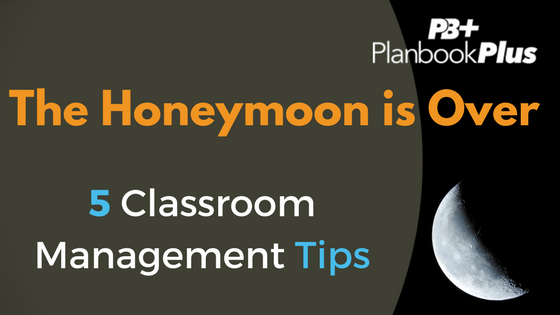
The Honeymoon is Over: 5 Classroom Management Tips
Those sweet September morns have come and gone. Students are over the excitement of seeing their friends and discussing their summer. Now, the demands are increasing on students. Additionally, homework is back in town and those pesky standardized test scores from last spring are rolling in. Students appear to be more and more stressed and anxiety-driven each and every year. As educators, we are challenged to engage students in our curriculum. Additionally, we are challenged to give each student an individualized education. Further, we are challenged to ensure that every student is provided safety and comfort in the classroom. And the list goes on and on.
Take a deep breath. You made it through one of the busiest months in the school year! Now that the students are situated and over the excitement of the beginning of the school year, we can get down to business! Now, that doesn’t mean it’s time to take the gloves off and crack the whip. It means it’s time to regroup, remind yourself why you are here, and challenge yourself to create the most engaging classroom that is conducive to learning! Lucky for you – we have some tips!
1) Teach STUDENTS, not content
Remember that we are here to teach students first. If your students are not engaging in instruction, then it is time to go back to the basics and develop relationships with your students. Of course, we have standardized tests, observations, and all of the other typical stressors. But how can we expect them to learn if they are not buying what you’re selling. Build your relationships. Determine what it is that motivates them, go to an extracurricular activity, and call the parents with some positive news.
2) Treat the BEHAVIOR – not the student
Spec Ed 101: treat the behavior first – not the student. Remember that there is an antecedent to every behavior. In other words – something is causing the behavior to occur. Perhaps the student missed breakfast or was up late packing lunch for their siblings. Maybe the student had to fend for themselves for dinner or forgot to take their medicine. There are endless reasons that may have caused them to engage in problem behavior. For that reason, teachers need to look at the behavior and treat that alone. Immediately redirecting a behavior could just escalate if you don’t have any glimpse into why the behavior occurred.
3) 3 Expectations, then IGNORE
Yes. Dare I say it…ignore. To nobody’s surprise, often times the desired consequence of student behavior is attention. The student in the middle of the class that calls out and eventually pounds on his desk – most likely attention-seeking. In your next class, try this simple method: 3 Expectations, then IGNORE. When the student calls out, remind them of the expectation (“I’m looking for a raised hand”). When the behavior happens again, reword your expectation (“I really like how Joey is raising his hand – thank you Joey!”). The third time the behavior occurs – provide one last expectation. After that, ignore the behavior. Don’t continue to give the student attention. Don’t kick them out of class and potentially give them a mode of escape. Just ignore it. You’ll be surprised how quickly the behavior is extinguished!
4) Immediate Positive Reinforcement
Positive reinforcement somehow gets a bad wrap. I’m not talking about giving the student a chocolate every time they raise their hand. However, when they start raising their hand – make sure they are the first one you call on (“Johnny THANK YOU for raising your hand!”). If they raise their hand and you are still speaking – acknowledge it and call on them when you are done speaking. They’ll love the attention, and they will learn how to appropriately get attention.
5) Plan, plan plan!
A former administrator once told me, “if a teacher has a well planned lesson, the likelihood of problem behaviors in the classroom are maybe 5%.” It’s the truth! This is where instruction comes back in to play. With the demands that students have on them, they don’t have time for wasted instructional time. Plan lessons that engage the students in meaningful instruction from bell to bell. Plan some “brain breaks” to keep them going and make it fun! Heck, we even have the perfect tool to help you plan!
Take some time on your ride to and from work to reflect on your classroom management skills. Give yourself a break, and realize that you are doing awesome things for students. Then, take at least one of these tips and try it out with your students! Good luck and THANK YOU for all you do!
